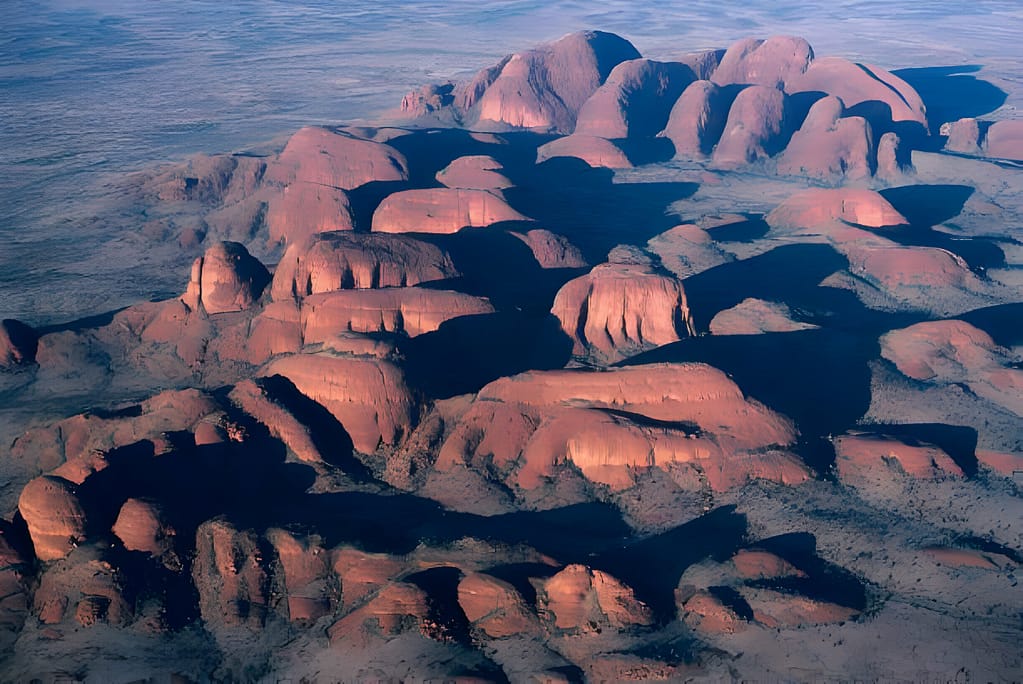Deep in the sun-baked heart of Australia’s outback, where ochre sands stretch endlessly beneath a cerulean sky, lies Kata Tjuta, a cluster of red sandstone domes that stand sentinel over the landscape. More than just geological marvels, these enigmatic formations, also known as the Olgas, hold within their silent embrace stories of ancient creation, resilient life, and enduring cultural significance.
Table of Contents
Mirage or Monument? A First Encounter

Your first glimpse of Kata Tjuta might well feel like a mirage shimmering across the heat-distorted plains. The 36 domes, rising from the earth like colossal pink haystacks, paint a scene of arresting beauty, etching itself onto your memory forever. Each dome, a unique masterpiece sculpted by wind and time, possesses its own distinct character, some rounded and smooth, others sharply defined, collectively creating a symphony of form and texture.
Towering over its brethren like a benevolent giant, Mount Olga, at 1,800 feet, almost twice the height of the Eiffel Tower, commands respect and awe. This formidable peak, the highest point in the Uluru-Kata Tjuta National Park, is a testament to the enduring power of nature. The other domes, some reaching half again the height of Uluru itself, stand shoulder to shoulder, creating a formidable and awe-inspiring spectacle.
Cleaving through the heart of Kata Tjuta, narrow chasms and ravines unveil a hidden world. The Valley of the Winds, a haven amidst the harsh desert, is a sanctuary where life clings tenaciously. Lush vegetation, from emerald acacias to fragrant mint bushes, paints vibrant strokes against the red rock walls, creating a surreal tapestry of contrasting beauty. Here, the wind whispers secrets through the ancient formations, carrying tales of resilience and adaptation.
Seeking a breathtaking vista? The Karingana Lookout offers a panoramic ode to Kata Tjuta, especially when bathed in the golden hues of sunrise. As the first rays of light caress the domes, they seem to glow from within, casting a mesmerizing warmth on the surrounding landscape. Witnessing this spectacle, one feels humbled by the sheer scale and majesty of nature’s artistry.
A Sacred Tapestry Woven in Stone
For the Anangu people, the traditional owners of the land, Kata Tjuta is far more than just a geological wonder. It is a sacred tapestry woven in stone, each formation, cave, and engraving holding deep spiritual significance. These are the footprints of the creation ancestors, their stories etched onto the rock face, forming part of the Jukurpa, or Dreaming, the guiding force of their lives. To walk amongst these sacred grounds is to step into a timeless realm, where the past whispers its secrets to the present.
Despite the harsh desert environment, Kata Tjuta teems with a surprising diversity of life. Bats find shelter in the cool crevices, while nimble wallaroos and sun-baked lizards dart across the rocks. Overhead, birds of prey, like the majestic wedge-tailed eagle, patrol the skies, their sharp eyes scanning for sustenance. This hidden ecosystem, a testament to the tenacity of life, reminds us of the delicate balance that exists even in the most seemingly barren landscapes.
The name “Kata Tjuta” itself carries the weight of history, reflecting the region’s rich cultural tapestry and colonial past. Originally named after Queen Olga of Württemberg by explorer Ernest Giles, the name has evolved over time. However, the allure and enigma of Kata Tjuta remain unchanged, a constant source of fascination for those who seek its secrets.
A Journey Beyond the Ordinary
Kata Tjuta, with its striking red domes, vibrant ecosystem, and profound cultural significance, is not just a destination; it’s an experience that transcends the ordinary. It’s a place to marvel at the power of nature, connect with ancient wisdom, and discover the resilience of life in the face of adversity. So, pack your sense of adventure and embark on a journey to Kata Tjuta, where the earth whispers secrets in sandstone domes, waiting to be unraveled by curious minds and open hearts.